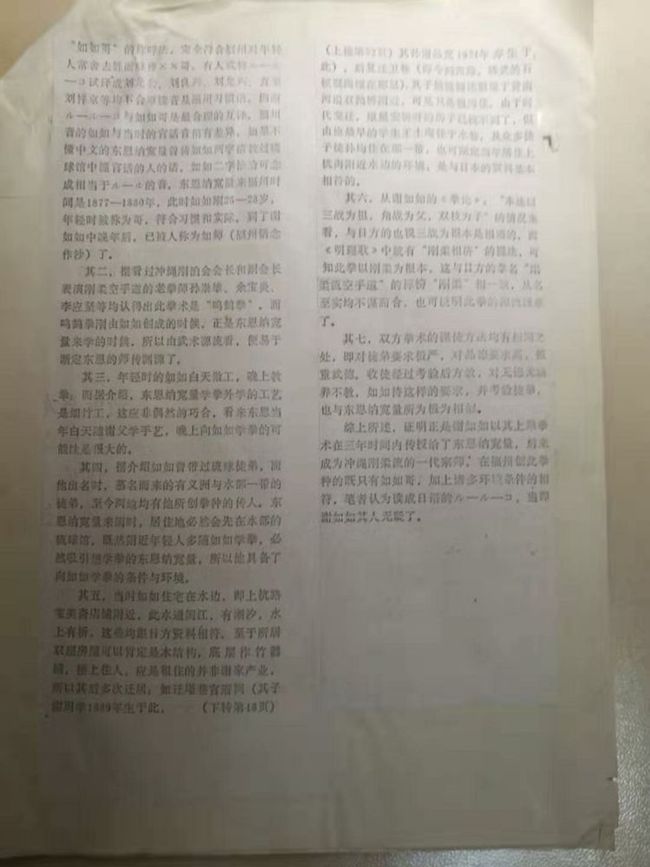a) 'September 16th, 1989' - when Lin Weigong made the official announcement that he had discovered the name of the Chinese Master of the 'Whooping Crane Fist' - that is 'Xie Chongxiang' (謝崇祥) [1852-1930]- also known as Xie Ru Ru (謝如如) and 'Ru Ru Ge' (如如哥) - who was the teacher of the Higaonna Kanryo [1853-1915] (from Okinawa) during the 19th century.
b) 'June 9th, 1990' - a black marble "Monument of Achievement" was raised in the southwest corner of the Fuzhou New Sports Centre by the Japanese and Okinawa Karate Association in memory of the Chinese Master Xie Ru Ru (謝如如) also known as 'Ru Ru Ge' (如如哥) - the Chinese teacher of the Okinawan Master Higaonna Kanryo!
Therefore, the year '2019' marks the 30th Anniversary of the announcement of the discovery of 'Xie Chongxiang' (謝崇祥) - whilst the year '2020' marks the 30th Anniversary of the raising of the black marble stele - and I believe the confusion (and conflation) of these two dates is the reason 'why' the news story continues to be associated with two different years (2019 and 2020). As not all of the historical data is present in any one single text (as the authors assume their readership already possesses a working knowledge of the story at hand), I have borrowed from at least three versions and have weaved a coherent historical narrative together. There was around eight months between Lin Weigong's historical announcement - and the Japanese - Okinawan Karate Association (representing 'Goju Ryu') organising the fund raising, commissioning, construction and transportation of the black marble stele - which is inscribed using Japanese language ideograms. The primary pictures in this article feature the stele and are dated from 1990 and 2000. The main stone tablet (and supporting base stele) both commemorate - with great respect - the eternal friendship that exists between China and Japan. This very close and fraternal relationship is embodied (and epitomised) through the creative (historical) interaction that took place between Xie Chongxiang and Higaonna Kanryo! May this interaction between the cultures of these two countries be forever fruitful! ACW (15.8.2022)

Kamiesu Choho, Hirota Nakaima and Kosuke Kamiya, etc.
https://www.it610.com/article/1225060581883613184.htm
https://88db.com.hk/QnA/Lesson-Instruction/空手道與褔建南拳的歷史淵源-剛柔流空手道的創造人在福建/1867
https://www.xuehua.us/a/5ebf28f07b5409df8eabbe2f?lang=zh-cn
Selection of Important Extracts:
老故事|30多年前林伟功受福建省政府之命为日本刚柔流空手道寻根
老故事|30多年前林伟功受福建省政府之命为日本刚柔流空手道寻根1988年夏,日本冲绳县有关部门在福州设宴感谢福建省政府副秘书长兼省旅游局局长南江等领导及为琉球国“闽人三十六姓”寻根的总查证人林伟功(福州市方志委人物志主编)等多年为冲绳寻根觅祖作出不懈努力及所做的贡献。
1989年9月16日,有關專家再次對謝如如是否做了進一步的論證,最後一致認為:謝如如(宗祥)確系日本沖繩剛柔流祖師東恩納寬量當年在福州所拜的中國武術師傅,並於1990年6月9日在福州市新體育中心西南角,矗立著一座莊嚴肅穆的黑色大理石“顯彰碑”,是日本沖繩空手道總會為紀念日本空手道剛柔流祖師東恩納寬量的中國師傅謝如如而立的紀念碑。這是中日武術界傳統中有源流方面影響的明證。
席上日方高野代表在再次致谢之余,提出希望请南江秘书长再安排林伟功主编将寻找日本刚柔流空手道中国鼻祖担当起来,南江秘书长给予接受,并让林伟功主编正式接受任务。宴后,在市方志办主任林萱治、黄启权的支持下,林伟功开展了艰辛的调查论证,发表了报告,并在副省长温附山的主持下通过论证会,确认福建省鸣鹤拳一代宗师谢如如是日本刚柔流鼻祖东恩纳•宽量的师傅,1989年取得圆满成功,并在省体育中心建立了显彰碑。


























 RSS Feed
RSS Feed